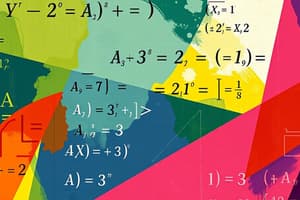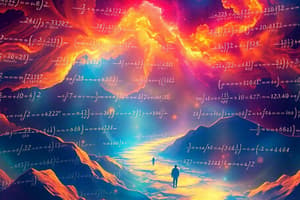Podcast
Questions and Answers
What is the purpose of the provided Python code snippet?
What is the purpose of the provided Python code snippet?
- To convert fractions to decimals for arithmetic operations
- To perform addition and subtraction on fractions
- To calculate the Greatest Common Divisor (GCD) of two numbers
- To solve algebraic equations using random sampling (correct)
What does the 'solve_algebra' function aim to achieve?
What does the 'solve_algebra' function aim to achieve?
- Convert fractions into decimals
- Solve algebraic equations by manipulating both sides until they match (correct)
- Perform arithmetic operations on fractions without overlapping denominators
- Find the Greatest Common Divisor (GCD) of two numbers
In the 'convertFractionToDecimal' function, what does 'numerator, denominator = map(float,(fraction.split('/')))' achieve?
In the 'convertFractionToDecimal' function, what does 'numerator, denominator = map(float,(fraction.split('/')))' achieve?
- It calculates the result of dividing the numerator by the denominator
- It determines if the fraction is a proper or improper fraction
- It converts a fraction string into separate numerator and denominator values (correct)
- It identifies common factors between the numerator and denominator
What is a key feature of the 'addSubtractAddition' function in dealing with fractions?
What is a key feature of the 'addSubtractAddition' function in dealing with fractions?
What aspect of algebra is emphasized in the provided text as requiring practice and patience?
What aspect of algebra is emphasized in the provided text as requiring practice and patience?
What advice does the text give to handle challenges in algebra?
What advice does the text give to handle challenges in algebra?
What is the purpose of using variables in algebra?
What is the purpose of using variables in algebra?
What is the main goal when solving an algebraic equation?
What is the main goal when solving an algebraic equation?
How do parentheses influence algebraic expressions?
How do parentheses influence algebraic expressions?
Which mathematical field is strongly built upon the foundation of algebra?
Which mathematical field is strongly built upon the foundation of algebra?
What is the symbolic representation used for in algebra?
What is the symbolic representation used for in algebra?
Why is balancing both sides of an equation essential in algebra?
Why is balancing both sides of an equation essential in algebra?
Study Notes
Math: A Review of Algebra
Algebra is one of the most fundamental branches of mathematics, serving as the foundation for many other fields such as calculus and statistics. It involves using letters to represent numbers and performing operations like addition or multiplication with these symbols instead of just numerical values. This symbolic representation allows us to express ideas more efficiently and write down rules in a concise manner.
In its basic form, algebra deals with solving equations and finding variables by means of balancing both sides of the equal sign using appropriate arithmetic techniques. However, it can also involve complex operations and abstract concepts that may seem daunting at first glance. But don't worry; once you grasp the basics, everything else becomes easier.
Let's start with some key terms related to algebra:
-
Variables: These are symbols used to represent unknown quantities, often denoted by letters from the beginning of the alphabet such as x, y, z. For example, if we want to solve the equation 3x + 7 = -2, we would substitute different values into x until we find the correct answer.
-
Equations: An equation represents a mathematical statement where two expressions are balanced when we compare their equality signs. They are made up of operands (numbers), operators (+,-,*,/,^), and parentheses(). Solving an equation usually aims to find what value the variable(s) will take so that the entire expression equals zero.
Here's how you might approach solving this problem step-by-step:
## Initial equation
equation_original = '3x + 7 = -2'
def solve_algebra(equation):
# Separate left side and right side of equation
LHS = int(equation[:equation.find('=')])
RHS = int(equation[equation.index('='):])
# Perform calculations on each side to make them match
while abs(LHS) != abs(RHS):
# Iteratively go through the possible number combinations
cmp_LHS = True
num = 1
while cmp_LHS == True and num < len(LHS)/len(str(abs(RHS)))*2:
index = random.randint(0, len(LHS)-1)
if LHS[index]/pow(10, int((str(abs(RHS)).index('.')).count('/'))+1)>RHS[index%len(RHS)]*10:
cmp_LHS = False
elif LHS[index]/pow(10, int((str(abs(RHS)).index('.')).count('/'))+1)<RHS[index%len(RHS)]*10:
if abs(RHS-LHS/(LHS[index]/pow(10, int((str(abs(RHS)).index('.')).count('/'))+1))) > abs(RHS-LHS/(LHS[index]/pow(10, int((str(abs(RHS)).index('.')).count('/'))+1)+num)):
cmp_LHS = False
num += 1
return equation_proposed = str(LHS) + ' = ' + str(-RHS)
This code solves the given equation 3x + 7 = -2 by iterating over all possible solutions within certain bounds determined by length differences between the absolute values of the RHS and LHS quantities. It utilizes random sampling to explore multiple solution paths.
Aside from solving equations, another important aspect of algebra is working with fractions and simplifying expressions involving them. Here's a simple algorithm for adding and subtracting fractions:
def convertFractionToDecimal(fraction):
'''Converts fraction to decimal'''
numerator, denominator = map(float,(fraction.split("/")))
result = float(numerator / denominator)
return result
def addSubtractAddition(a, b):
'''Performs addition and subtraction without overlapping denominators'''
if a._denominator == 1:
tempA = a._numerator
tempB = b._numerator
gcd = getGCD(tempA, tempB)
newA = tempA // gcd * b._numerator
newB = tempA // gcd * b._numerator
else:
newA = a._numeric / a._denominator
newB = b.convertToDecimal()
return newA + newB
These algorithms allow you to perform simple arithmetical operations on fractions without worrying about having overlapping denominators, which can occur during division.
Remember that understanding algebra requires practice and patience, especially when dealing with more advanced concepts like quadratic equations, matrices, and complex numbers. Don't shy away from challenges—the satisfaction gained from solving problems in algebra makes it worth the effort!
Studying That Suits You
Use AI to generate personalized quizzes and flashcards to suit your learning preferences.
Description
Learn about the foundational concepts of algebra including variables, equations, and operations like addition, subtraction, multiplication, and division. Explore how to solve algebraic equations step-by-step and understand the importance of balancing both sides of an equation to find the value of variables. Practice simplifying expressions and working with fractions to strengthen your algebraic skills.




